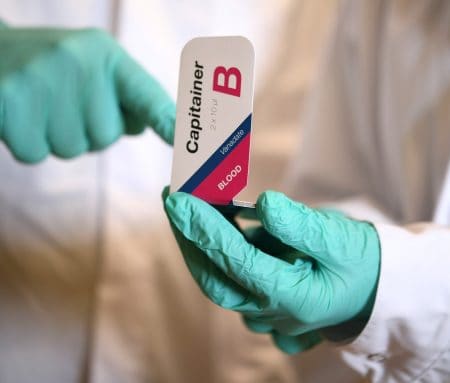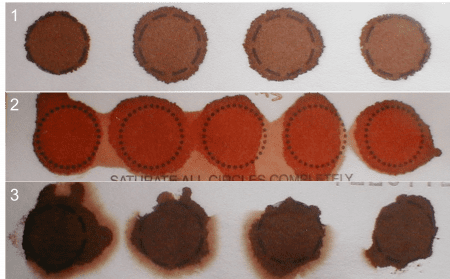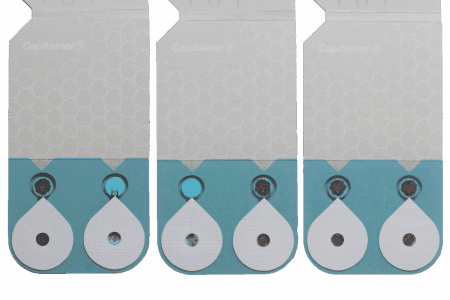Traditional PEth testing may yield unreliable results
Traditionally, PEth is analysed from venous blood draws taken by a trained phlebotomist.
One major problem with traditional testing is that PEth will continue to form in vitro post-sampling if any amount of ethanol is present in the blood at the time of the blood draw.
In vitro PEth formation can make it impossible to distinguish between mild and chronic or binge alcohol consumption. This may make traditional PEth analysis results unreliable.
Capitainer®B Vanadate eliminates the risk of false positive samples
In vitro PEth formation can be prevented by inhibiting PLD activity immediately after blood sampling. Sodium metavanadate (NaVO3) has been shown to be an effective PLD inhibitor, and this is incorporated into our Capitainer®B Vanadate device for accurate and reliable PEth testing.
The Capitainer®B Vanadate device is, like all Capitainer’s products, based on the well-established dried blood spot (DBS) sampling method. Our proprietary technology of incorporating NaVO3 in the DBS paper disc eliminates the risk of PEth formation post-sampling, thus bypassing the false-positive risk associated with other PEth testing methods. Capitainer®B Vanadate has been demonstrated to outperform PEth testing from traditional venous samples (Beck et al., 2021, Schröck et al., 2018).
Conventional DBS makes it difficult to determine sample volume
Conventional DBS is widely used for qualitative or semi-quantitative analyses such as screening for the rare disorder phenylketonuria (PKU) in newborns. While DBS has proven successful in qualitative analyses, PEth analysis relies on the quantification of PEth in a person’s blood at a specific time point. A quantitative analysis requires an exact sample volume.
How big is a blood droplet from a finger prick? This depends on many factors, including the size of the lancet needle using for blood drawing, individual blood circulation, and hand temperature of the person being tested, to name a few.
When the drop of blood is released onto a conventional DBS filter, it is impossible to determine the exact sample volume. A common practice is to sub-punch the filter to produce a disc of known size, which is assumed to harbour a fixed blood volume. Although widely used, this accuracy of this approach is hampered by the hematocrit effect, whereby the haemoglobin level in the blood influences its viscosity, which in turn influences how the blood diffuses through the filter (Denniff & Spooner, 2010). This may lead to sub-punches from different regions yielding completely different PEth readings. The hematocrit effect, which is a well-documented phenomenon, renders conventional DBS unsuitable for accurate PEth analysis.
How big is a blood droplet from a finger prick? This depends on many factors, including the size of the lancet needle using for blood drawing, individual blood circulation, and hand temperature of the person being tested, to name a few.
When the drop of blood is released onto a conventional DBS filter, it is impossible to determine the exact sample volume. A common practice is to sub-punch the filter to produce a disc of known size, which is assumed to harbour a fixed blood volume. Although widely used, this accuracy of this approach is hampered by the hematocrit effect, whereby the haemoglobin level in the blood influences its viscosity, which in turn influences how the blood diffuses through the filter (Denniff & Spooner, 2010). This may lead to sub-punches from different regions yielding completely different PEth readings. The hematocrit effect, which is a well-documented phenomenon, renders conventional DBS unsuitable for accurate PEth analysis.
1. Ideal blood spot which fills the dashed circles. Exact volume unknown, but approximately 50-75 uL of blood
2. Blood spots that were not dried prior to shipping to the laboratory as identified by the bright red of fresh blood versus rust color of dried blood. These spots also have serum rings and bleed into each other. The volume of blood would be highly variable even if punch after drying by the laboratory.
3. Blood spots that contain serum rings that could produce a highly variable hematocrit. One of the spots (left) looks like it was double spotted based on the intensity of the color.
Image provided by Donald Chace, PhD
Accurate sample volume every time with Capitainer®B Vanadate
Capitainer®B Vanadate bypasses the hematocrit effect, and provides a unique solution to PEth testing by ensuring a sample volume of exactly 10µl, every single time.
In our device, the DBS disc is pre-cut prior to blood sampling to perfectly fit the wells of a standard 96-well plate. Since Capitainer® B Vanadate uses the full disc for PEth testing, the hematocrit effect can be disregarded.
A Capitainer spot is always perfectly filled with 10µl or unsuccessful. Samples between perfect and empty spots does not exist, this is secured by the microfluidic technology inside the card.
Capitainer®B Vanadate – the new gold standard for PEth analysis
Capitainer®B Vanadate is a microsampling device that can be used for both self-sampling and assisted sampling. A blood sample is taken by the device through a finger prick and a droplet of blood is automatically applied to the integrated DBS filter. The user will receive an instant confirmation on the device if the sampling is successful. In other words, no responsibility is put on the end user to decide whether or not the sample volume is correct, since this process is completely automated within the device.
The Capitainer®B Vanadate device is proven to be very user-friendly and does not require the presence of a phlebotomist. By following the instructions for use, self-sampling or assisted sampling is performed efficiently, ensuring an accurate blood sample for analysis.
Since the blood in the disc is dry, it is not considered a biohazard, which means that the sample neither requires refrigerated transportation nor cold storage before analysis. This important feature enables any laboratory to receive samples from a much greater geographical area than would otherwise be possible. Lab automation and protocols for mass spectrometry, which are already up and running in laboratories in Sweden, are available from us upon request.




